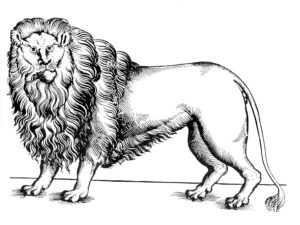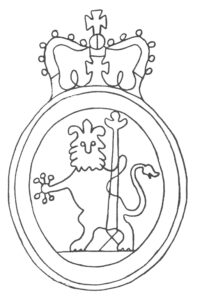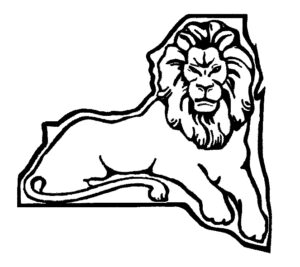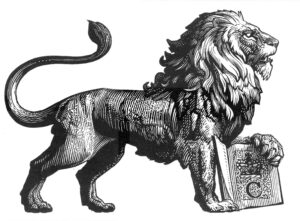The Story of the RBS Lions
The following text, by RBS Founding Director Terry Belanger, appeared in slightly different form in the 2008 Book Arts Press Address Book (which in turn was drawn from the 2002 RBS Christmas card; some of the earlier text has been re-incorporated).
The RBS Lions
 Back in our Columbia days, I used to keep a folder containing pictures of interesting lions I came across in periodicals and catalogs, for potential use on posters and brochures: Columbia University (founded as King’s College in the 1750s) had long associated itself with British royal insignia, crowns and lions in particular. Twenty-five years ago, when I needed an image to help advertise the first Rare Book School, I went to this folder, pulled out the engagingly goofy-looking lion shown to the left, and incorporated it into the flyer for RBS 1983, published in December 1982.
Back in our Columbia days, I used to keep a folder containing pictures of interesting lions I came across in periodicals and catalogs, for potential use on posters and brochures: Columbia University (founded as King’s College in the 1750s) had long associated itself with British royal insignia, crowns and lions in particular. Twenty-five years ago, when I needed an image to help advertise the first Rare Book School, I went to this folder, pulled out the engagingly goofy-looking lion shown to the left, and incorporated it into the flyer for RBS 1983, published in December 1982.
 I used this lion again on the RBS 1984 flyer—but this time around, the mailing prompted a letter from one Dave Oliphant, Senior Editor of Humanities Research Center Publications at the University of Texas. “Dear Sir or Madam,” he wrote, “today we received a copy of a brochure publicizing your Rare Book School. On this brochure there appears a reproduction of what we take to be a copy of a rare c16 image from our collections here at the Humanities Research Center. This image from a German broadside presents a full-sized lion with anthropomorphic features in the face. Since the image you have reproduced contains the exact hairline tear that appears in our broadside, we find it likely that this is in fact a copy of our image.” Mr Oliphant continued, “So far we have found no record of your having asked permission to use this image.”
I used this lion again on the RBS 1984 flyer—but this time around, the mailing prompted a letter from one Dave Oliphant, Senior Editor of Humanities Research Center Publications at the University of Texas. “Dear Sir or Madam,” he wrote, “today we received a copy of a brochure publicizing your Rare Book School. On this brochure there appears a reproduction of what we take to be a copy of a rare c16 image from our collections here at the Humanities Research Center. This image from a German broadside presents a full-sized lion with anthropomorphic features in the face. Since the image you have reproduced contains the exact hairline tear that appears in our broadside, we find it likely that this is in fact a copy of our image.” Mr Oliphant continued, “So far we have found no record of your having asked permission to use this image.”
It turned out the lion in my folder had appeared in a brochure advertising the University of Texas’s quarterly Library Chronicle. At some point before December 1982, I must have received a copy of this flyer in the mail, cut the lion out, and filed it, without thinking of the copyright implications. I wrote at once to apologize to Decherd Turner, then Director of HRC, and threw myself on his mercy. He replied very kindly: “I like lions,” he said, “and I think the ambience of the king of beasts is sufficiently large for all of our needs. … There is no charge for usage.”
The RBS 1984 flyer grew from legal to tabloid size in order to provide room for 20 course descriptions (up twelve from the year before; when he received the expanded list of courses, Robert Rosenthal predicted that we would soon be bankrupt). Because of its larger dimensions, the RBS 1984 flyer had room for a second lion, and I found an appealing one on a sheet of 1823 English watermarked paper we had recently acquired as part of a portfolio of paper samples—particularly suitable because the watermark contained not only a lion but also the British royal crown.
We all liked the watermark lion, and we began to use him on a regular basis in RBS publicity, both alone and in conjunction with a variety of other lion images, sometimes with lettering (designed by John Downer) in the surrounding oval providing Columbia identification, and sometimes on his own. 
In 1984, Justin Schiller showed a circus advertisement with some splendid lions in it at an antiquarian book fair; he very kindly lent us one of these images for the RBS 1985 brochure. David Cundy designed the RBS 1988 flyer, with the intelligent result that we shifted from a poster to a four-page 8.5 x 11 inch format, that year using a Thomas Bewick lion with a r-r-roar that Cundy told me later he never thought he could get approved (but did: RBS is serious, but not too serious). For the RBS 1989 brochure, we took a lion (at right) off the decorated cloth cover of a 1902 novel by M. L. Luther called The Henchman, remarkable for its clever incorporation of a sitting lion within the outline of New York State.
 This design seemed appropriate in a Columbia context, as did the lion we used for the RBS 1990 brochure, a magnificent wood-engraving (at left) that James Davis commissioned for us from the well-known English artist/wood-engraver Simon Brett. The crown and capital C seemed just right at the time—but as it happened we were able to use the wood engraving only once in its original form on a brochure; when RBS and self moved to the University of Virginia in 1992, the Columbia insignia were no longer wanted.
This design seemed appropriate in a Columbia context, as did the lion we used for the RBS 1990 brochure, a magnificent wood-engraving (at left) that James Davis commissioned for us from the well-known English artist/wood-engraver Simon Brett. The crown and capital C seemed just right at the time—but as it happened we were able to use the wood engraving only once in its original form on a brochure; when RBS and self moved to the University of Virginia in 1992, the Columbia insignia were no longer wanted.
![]() In 1993, the watermark lion walked permanently out of his oval frame and crown, lost his batons, and acquired a V platform. Once out of his cage he never looked back: he began to teach (RBS 1994); he mastered octavo format (RBS 1995); he played ringmaster in a three ring-circus (RBS 1996); he ran a common printing press (RBS 1997); and he otherwise made himself generally useful both summer and winter on both RBS brochures and notions (first on mugs, then on aprons, then on tape measures and T-shirts, then on cloth bags and key chains, and most recently on polo shirts), as well as in the RBS Travel and Housing Guide, the RBS Student’s Vade Mecum, and the RBS website.
In 1993, the watermark lion walked permanently out of his oval frame and crown, lost his batons, and acquired a V platform. Once out of his cage he never looked back: he began to teach (RBS 1994); he mastered octavo format (RBS 1995); he played ringmaster in a three ring-circus (RBS 1996); he ran a common printing press (RBS 1997); and he otherwise made himself generally useful both summer and winter on both RBS brochures and notions (first on mugs, then on aprons, then on tape measures and T-shirts, then on cloth bags and key chains, and most recently on polo shirts), as well as in the RBS Travel and Housing Guide, the RBS Student’s Vade Mecum, and the RBS website.
What is a fairly serious scholarly institute doing with a cartoon mascot? Not the world’s most original icon, our lion: San Marco and Löwenbräu and Trafalgar Square and NYPL and the Art Institute of Chicago and (God bless us, every one) Columbia University all beat us to it … to say nothing of The Lion King. Richard Wendorf once put as his entire reason for wishing to take an RBS course, “No good reason”: like Decherd Turner, I guess we just like lions.
See the RBS Lions page for a large sampling of the various iterations of the lion over the years.
